
3 Big Reasons to Buy Dividend Growth Stocks Now
Volatility is back on the front burner.
Jitters range from the economic and inflationary impact of tariffs, to rising 10-year Treasury yields, to what DeepSeek means for the future of AI.
All these narratives affect interest rates. And that bodes well for one patch of the income spectrum: Dividends.
We’ll offer 3 big reasons to buy dividend growth stocks now.
If you want to review our piece from January 27, when we told you High Interest Rates Won’t Kill the Equity Rally, go right ahead.
We believe 2025 is likely to be choppier than the uninterrupted moonshots of 2024 and most of 2023. And as we’ll highlight, dividend growth offers an all-weather strategy that can thrive in more uncertain times.
There are 3 huge macro tailwinds to be aware of.
Stay with me and we’ll show you how to maximize the theme with a leading dividend growth ETF.
Finally, we’ve put together an all-star dividend growth list for members.
Reason Number 1 to Buy Dividend Growth Stocks: They Outperform When Volatility Rises
Albert Einstein once described compound interest as the “eighth wonder of the world.” He was 100% right.
Since 1930, the S&P 500 is up only 6.7% a year excluding dividends vs. 10.4% with payouts reinvested.
The ability of high-quality companies to reliably grow their payouts year-in and year-out takes the “compounding” effect Einstein referenced to the next level.
You’re not re-investing the same amount every year. The annual growth of your re-invested payouts supercharges long-term compounding.
Since 2000, S&P 500 dividends have grown 6.9% per year from $139B to an estimated $585B for 2025.
Given the long-term value of growing payouts, it’s no surprise that dividend growth acts as a hedge against volatility.
Since 1990, companies with the financial strength to grow their dividends outperformed during volatile markets.
The VIX is the leading gauge for measuring S&P 500 volatility.
In all months when the VIX Index increased, dividend growers beat non-dividend paying stocks.
Even better, the more volatility rises, the more dividend growth stocks outperform.
The VIX is up over 20% in February. Since 1990, in months when the VIX rose over 20%, dividend growers outperformed non-payers by 1.9% (chart).
Dividends offer ballast in stormy seas:
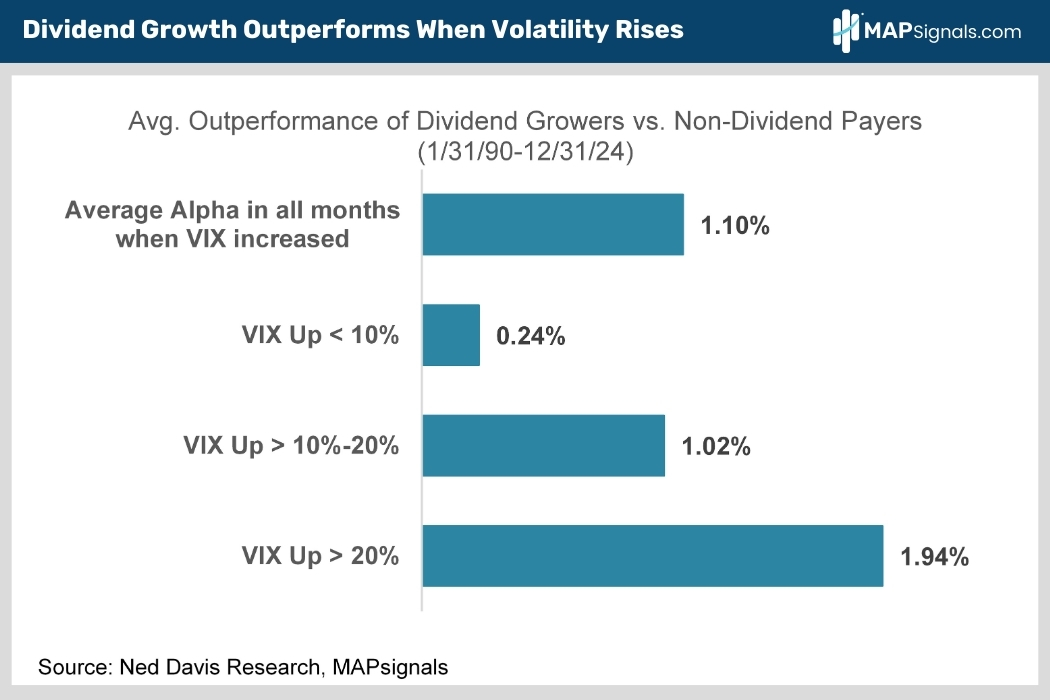
Reason Number 2 to Buy Dividend Growth Stocks: Dwindling Bond Returns
Bonds play a critical risk management role in investment portfolios. They can zig higher when stocks zag lower - usually when recession fears threaten corporate earnings.
We’re not suggesting eliminating bond exposure. But times have changed, and smart investors need to change with them.
Juicy 5% bond yields are being wiped out as rising long-term interest rates pressure bond prices.
The Bloomberg US Aggregate Bond Index – the leading US fixed income benchmark – has produced just -0.6% and 1.2% annualized total returns, over the last 5 and 10-years, respectively.
From the early eighties through mid-2020, bonds enjoyed an epic bull market as yields fell from the mid-teens to less than 1%. Not only did investors earn generous income, their total returns were padded by falling interest rates (bond prices move inversely to bond yields).
But the party’s over. We’re in a bond bear market. Rates have been rising for five years and show no signs of heading sustainably lower thanks to record deficits and unprecedented political partisanship.
So what’s an income investor to do? In a word, diversify! Dividend growth stocks are a great alternative to part of your bond allocation.
Check out this chart: Over the last decade, the leading bond index has only gone up a scant 13% including reinvested interest as 10-year Treasury yields have shot up 126% to 4.5%.
Compare that to the 211% and 161% respective returns of the leading US dividend growth and high dividend indices (chart). That gap is too big to ignore. It’s not even close!
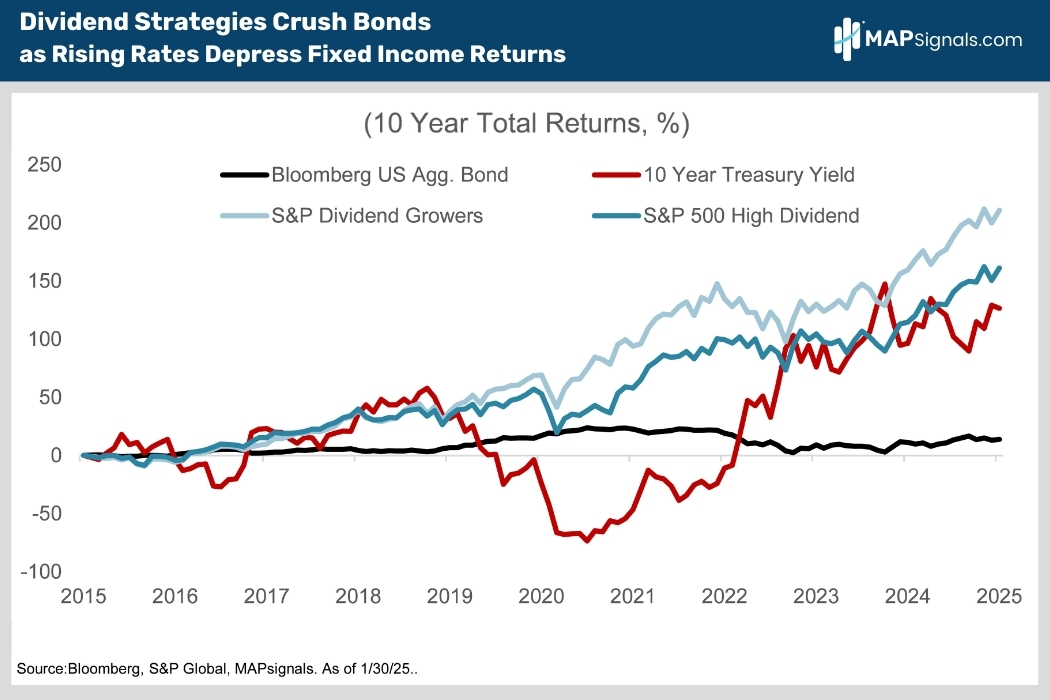
If rates keep rising don’t expect dividend stocks’ huge lead to shrink much.
Reason Number 3 to Buy Dividend Growth Stocks: Record Earnings & Low Payouts
Dividend growth is forecast to rise to 8.7% this year led by industrials, real estate, and financials (chart).
That’s a cyclical mix worth paying attention to in 2025:
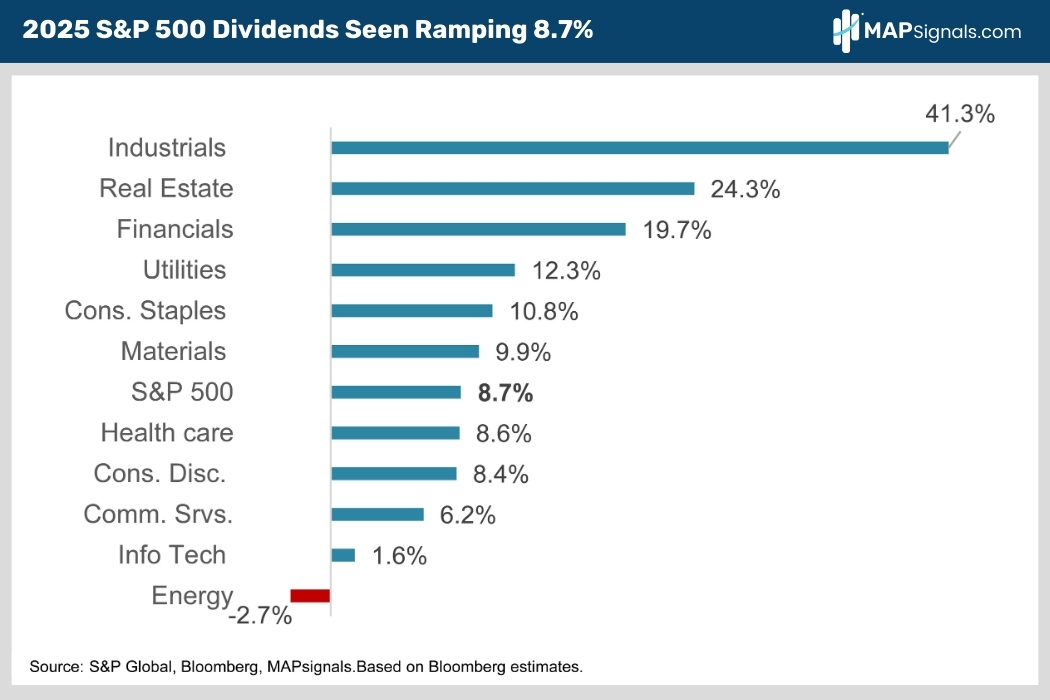
Here’s what’s driving the bull market in dividend growth:
- Record corporate profitability. Dividends can’t grow quickly if profits don’t. S&P 500 earnings are seen rising 13% this year – almost double their 7.1% long run average (chart).
- Low payout ratios: The S&P’s payout ratio – the percentage of profits its constituents use to cover dividends – is still only 36%, well below its 45% long-run average (chart).
That leaves lots of room to raise payouts!
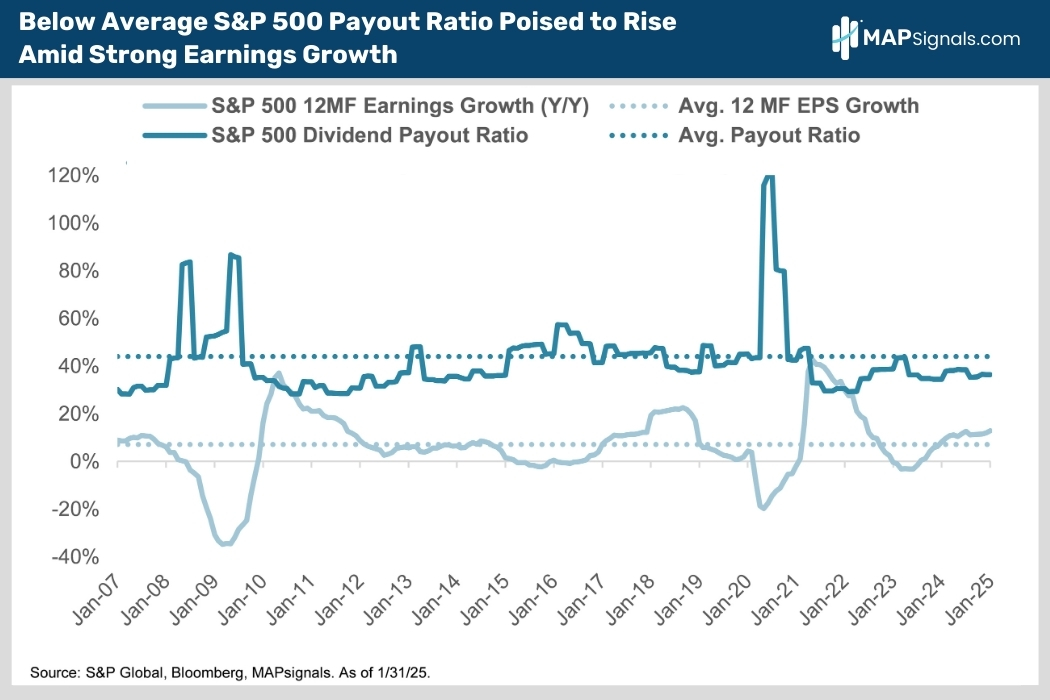
Now for the fun part – how to play it.
How to Tilt Your Portfolio
We’ve made the macro case for dividend growth stocks. Now, let’s tackle portfolio construction.
We know big yields are tempting, but a sky-high dividend yield often signals distress. The payout may be high because the company's shares have fallen either due to poor fundamentals, or it’s the only way to entice investors to buy the stock, or both. Think CVS (CVS), Verizon (VZ) or Whirlpool (WHR), ouch!!
Either way, it’s a head fake and that juicy yield is often wiped out by a few months of capital losses.
It’s no surprise that dividend growth strategies consistently outperform their high dividend yield counterparts (chart).
The bottom line is quality matters, which is what we preach at MAPsignals. Dividend growth stocks have a return on equity of 27% vs. only 17% for high dividend stocks.
It’s impossible to consistently grow your dividend without impressive financial strength. Over time, that beats high, but iffy, yields.
Let’s compare 2 dividend ETFs: VIG vs VYM.
Vanguard’s $103B Dividend Appreciation ETF, VIG, tracks the S&P’s Dividend Growers Index which requires 10 years of dividend growth for inclusion. VIG yields 1.7% and sports a rock-bottom 0.06% expense ratio.
VIG’s MAP Score of 61 reveals healthy institutional buying without being anywhere near overbought (think 80+).
By contrast, our ETF ranking for the smaller, $73B Vanguard High Dividend Yield ETF, VYM, also a category leader, is only 59.
Note how VIG has consistently outperformed VYM outside of last year:
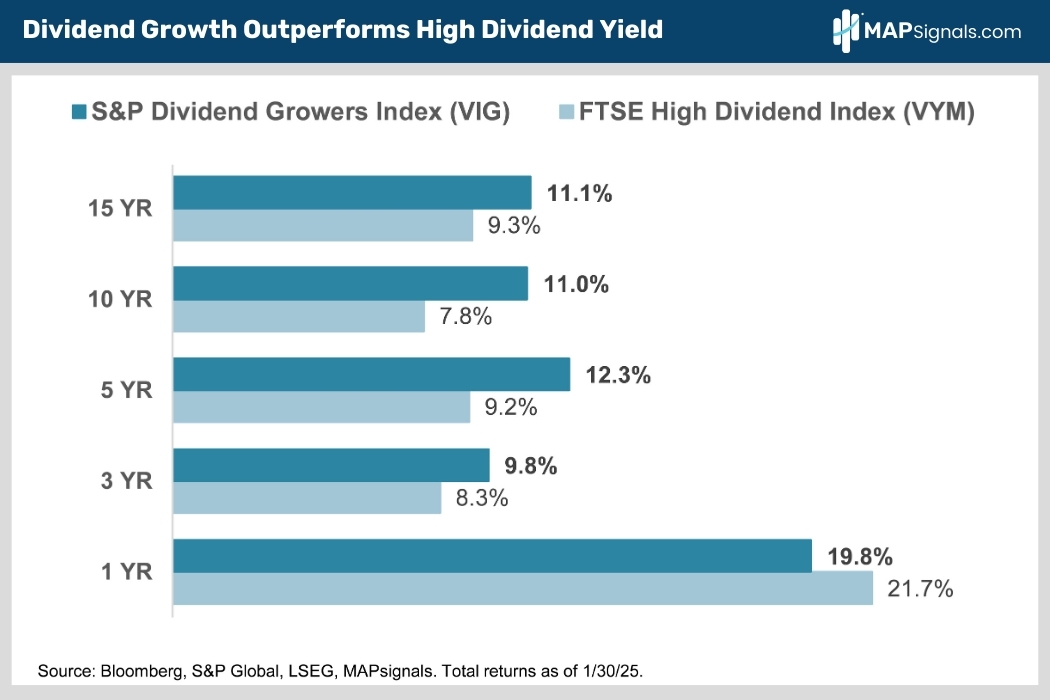
VIG’s more cyclical sector allocation is another reason to favor dividend growth over high yields (chart).
We’re bullish on cyclical stocks because we think more “goldilocks” growth and inflation is in the cards as tariffs turn out to be less onerous than feared, allowing the Fed to continue cutting rates.
Dividend growth is well positioned thanks to its large, high quality exposure to the growthy tech sector, coupled with big allocations to industrials, financials and health care – much of which isn’t defensive – biotech, medical devices etc...
It also has much less exposure to counter-cyclical utilities and the yo-yo energy patch where rallies never seem to stick (chart).
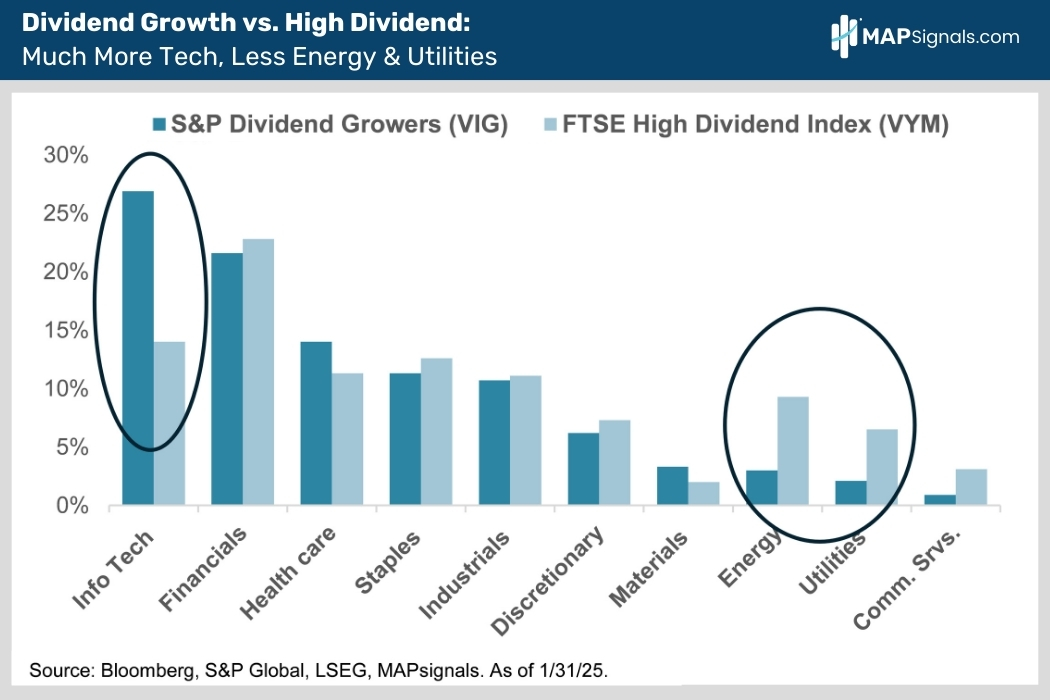
Quality matters when it comes to dividend stocks.
We’ve put together an all-star list of 32 Top-ranked dividend growth stocks. Their low payouts and solid businesses make them the creme de la crème.
This article is accessible to MAP Pro memberships.
Continue reading this article with a MAP Pro Subscription.
Already have a subscription? Login.
